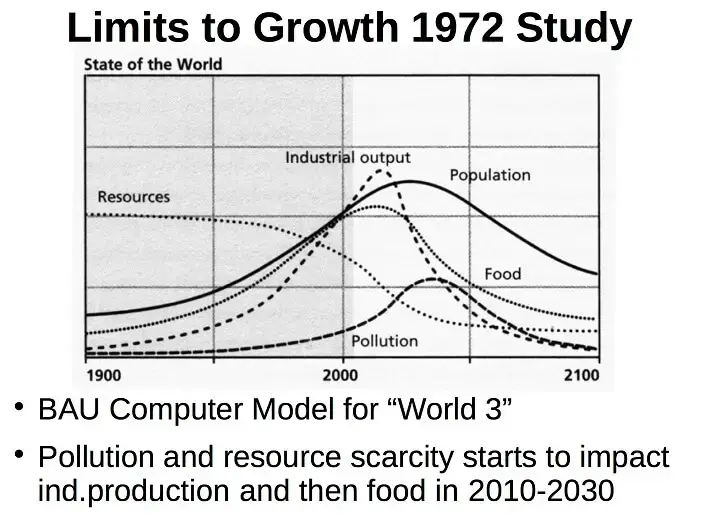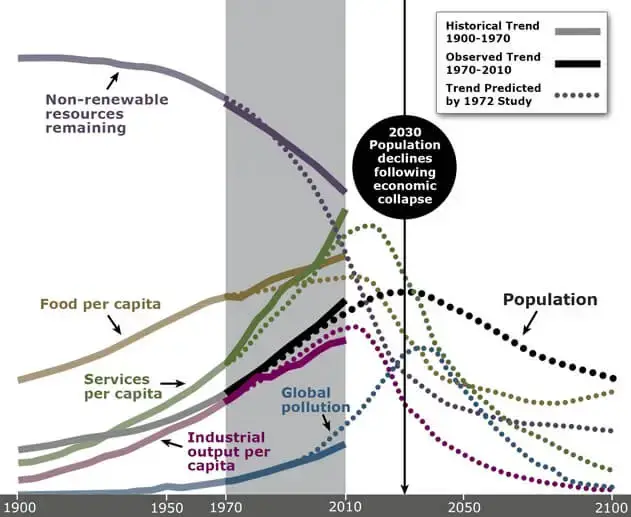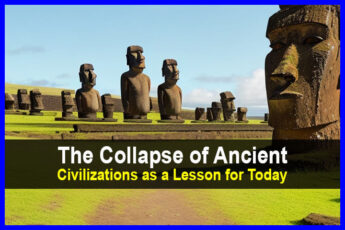Estimated reading time: 9 minutes
In 1972, a group of researchers from the Massachusetts Institute of Technology (MIT) released a computer-generated report at the Smithsonian Institution investigating five major trends affecting the future stability of world society.
The report was titled Limits to Growth and was inspired to some degree by Paul Ehrlich’s thesis put forward in his book The Population Bomb. Ehrlich predicted that the aggregate world demand for resources coupled with population growth would lead to future starvation. (You can read the Limits to Growth book for free right here.)
Limits to Growth (LTG) went beyond general resource and population measurement to assess the future status of five critical factors or trends that define the success of society. The five trends measured and assessed included:
- Accelerating industrial development
- Rapid population growth
- Widespread malnutrition
- Depletion of nonrenewable resources
- Deteriorating environment
The foundation of the equation was simple. Any population needs certain products and services from food and water to housing, clothing, furniture, appliances, and in many industrialized countries – automobiles, TV’s, and new and emerging inventions and electronics.
The reality is that any product or service requires the use of resources to be produced or to function, and that the production of anything from electricity to food to automobiles results in varying degrees of waste products polluting the environment while depleting the supply of available resources.
Complicating matters is that as a population increases, its demands for more products and services increases. The fundamental question was: When does a society exceed its ability to provide fundamental and luxury goods and services because of diminished resources or excessive pollution?
The researchers made no assumptions about the end result and assumed it would simply indicate basic course corrections to manage growth in the future. They were stunned when the computer delivered conclusions indicating that the five factors would collectively lead to a collapse of global society around 2040.
The conclusion of the LTG report in 1972 stated:
If the present growth trends in world population, industrialization, pollution, food production, and resource depletion continue unchanged, the limits to growth on this planet will be reached sometime within the next one hundred years. The most probable result will be a rather sudden and uncontrollable decline in both population and industrial capacity.

Fortunately, it was only 1972 and it seemed like there was still time to make changes and alter the course of events. That wasn’t the case.
Controversy Soon Followed
The report was greeted with significant criticism by four general groups:
- Those who saw the book as a threat to their business or industry.
- Professional economists, who saw LTG as an uncredentialled encroachment on their profession.
- The Catholic church, which bridled at the suggestion that overpopulation was one of mankind's major problems.
- The political left, which saw the LTG study as a scam by the elites designed to trick workers into believing that a middle-class, proletariat paradise was a pipe dream.
New Projections Emerge
As time went on, the report was somewhat forgotten by some and ignored by many. But then something curious happened. Disturbing follow-up reports confirmed the projections of the original 1972 study.
The most recent report on LTG took place in 2020 with an analysis by Gaya Herrington, then Director of Sustainability Services of KPMG US and was published in Yale University's Journal of Industrial Ecology.
The 2020 study examined updated quantitative information about ten factors including the five trends in the original LTG report:
- Population
- Fertility rates
- Mortality rates
- Industrial output
- Food production
- Services
- Non-renewable resources
- Persistent pollution
- Human welfare
- Ecological footprint
The 2020 analysis concluded that the Limits to Growth prediction is essentially correct in that continued economic growth is unsustainable under a “business as usual” model.
The new study found that current empirical data is broadly consistent with the 1972 projections, and confirmed that if major changes to the consumption of resources are not undertaken, economic growth will in fact peak and then rapidly decline by around 2030, with total collapse of civilization happening around 2040.

The telegram is that if we don’t change the way we live, eat, and buy all of the things that we’re used to doing without a thought, we will soon either be without them or not able to afford them. If that’s starting to sound familiar, it gets worse.
The Original LTG Study Was Actually Optimistic
As the original indications of the 1972 analysis continue to be studied a glaring reality emerged. The original computer model was in fact highly optimistic in its projections. It did not include any measurement of:
- Military sectors in many nations continuously draining capital and resources from a productive economy.
- Did not consider ethnic strife as a factor or trend.
- Did not evaluate the effects of war on people, capital, destroyed buildings and land, or new forms of pollution (chemical, radioactive).
- Did not factor in the affects of political and systemic corruption.
- Omitted potential impacts from still unknown pandemics like AIDS, tuberculosis and COVID-19.
- And while it did identify potential climatological affects of pollution, it did not fully explore the broad impacts of climate change nor factor in emerging and growing impacts of wildfires, floods, drought, and global water shortages on an industrial economy.
What should give us pause is that many of the projections from Limits to Growth are occurring right now. What may be making them hard to see is the distraction of recent events.
- “Food prices are higher, but that’s because of the supply chain problems from COVID-19.”
- “Gas prices are higher, but that’s because Russia invaded Ukraine”
- “Inflation is happening, but that’s because everyone still has extra money to spend from those stimulus payments.”
- “We’re not in a recession, it’s just some kind of short-term thing.”
- “It’s all Trump’s fault.”
- “No, it’s all Biden’s fault.”
Meanwhile…
The ice caps are melting, sea levels are rising, the average global temperature is approaching critical mass for permanent climate change, water shortages are devastating crops and cattle.
The global population is months away from 8 billion, we’ve passed the point of peak oil (when oil production is easy and cheap as a resource), and we’re a few years away from 90% global deforestation of unprotected woodlands.
It's so bad that scientists are now saying we only have a 10% chance of surviving the next few decades without societal collapse.
And the Distractions Continue
Instead of doing any of the actionable steps to achieve a sustainable society through the responsible management of population growth and resource usage, we’ve continually distracted by the media myopia of political bickering, advertisements for more things we don’t need, and the desperate need of many to cling to life and business as usual.
But Why Can’t Technology Fix It?
The promise of new and emerging technologies to solve all of our problems is a common argument for a business as usual approach to the way society functions today. It was one of the primary arguments for dismissing the conclusions raised in Limits to Growth.
- “Who needs oil when solar power and electric cars will fill the gap?”
- “Genetically modified foods and crops will give us better yields and more crops per acre.”
- “We invented synthetic rubber during World War II and we’ll always be able to find a substitute for anything.”
The argument for technology is often summarized as the belief that our greatest resource is our resourcefulness. It’s the assumption that if we run out of something, we’ll find a substitute. But that misses a fundamental fact explored in Limits to Growth and that fact comes from the title of the study: “limits.”
Regardless of the brilliance of new inventions or innovations, they require new and old resources to be developed and result in new and additional waste products or pollutants as a result of their manufacture.
And their manufacture will also and ultimately exhaust the new resources while adding a new level of pollutants to the world’s ecosystem. Those are in fact the fundamental foundation elements of LTG as stated by its authors:
“Without substantial changes in resource consumption, the most probable result will be a rather sudden and uncontrollable decline in both population and industrial capacity”.
It’s not about changing the resource but changing our consumption of any resource. So what’s the Answer? In a word: “sustainability.”
Transitions to a Sustainable World
The world can respond in three ways to resource use and pollution emissions:
- Disguise, deny, or confuse the signals. Generally, this takes the form of efforts to shift costs to those who are far away in space and time: our children and grandchildren or people and populations who can’t do anything to stop us. An example would be to buy air conditioners for relief from a warming climate, or to ship toxic wastes for disposal in a distant region. Common occurrences today in both instances.
- Alleviate the pressures from limits by employing technical or economic fixes. For example, reducing the amount of pollution generated per mile of driving or per kilowatt of electricity generated. These approaches are only a stop-gap and will not eliminate the causes of these pressures.
- The third way is to work on the underlying causes, to recognize that the socioeconomic system has overshot its limits, is headed toward collapse, and therefore seek to change the structure of the system to a sustainable model.
Unfortunately, the behaviors of the first way defined by disguise, denial and confusion seems to be our current approach to the realities of our limits to growth. Many of the limits analyzed in the original 1972 study have already been exceeded or “overshot” including population, pollution, and natural resources like oil.
Many of the voices calling for moderation in rapid growth are mocked and dismissed as doomsayers and survivalists. What’s unfortunate is that the planet those doomsaying survivalists meekly inherit will be a far cry from the paradise we once lived in and never really appreciated.
The only good news is that most survivalists know more than a thing or two about sustainability.
This article was originally published on Urban Survival Site.
Like this post? Don't Forget to Pin It On Pinterest!









